Sort the numbers 0, 1, 2, …, 123456 into two sets. In one set put all the numbers who digits add to an even sum; in the other put those whose digits produce an odd sum. Which set is larger?
Think Piece
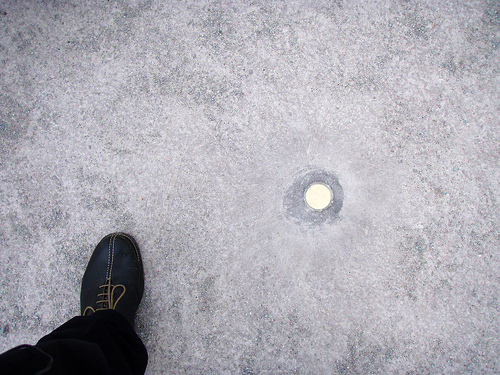
To create the conceptual artwork Vertical Earth Kilometer, Walter De Maria drilled a hole in the Friedrichsplatz Park in Kassel, Germany, and inserted a brass rod 1 kilometer long.
The rod exists underground, but only its top, a coin of brass 5 centimeters wide, is visible. Is art still art if it can’t be experienced by the senses?
So There
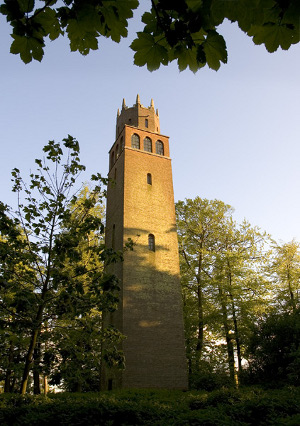
The eccentric Gerald Tyrwhitt-Wilson, 14th Baron Berners, erected a “useless” 100-foot tower on his property in 1935.
He added a notice: MEMBERS OF THE PUBLIC COMMITTING SUICIDE FROM THIS TOWER DO SO AT THEIR OWN RISK.
(At the opening, guests were invited to bring up to six effigies of enemies to be thrown on a bonfire; one complained that this was “most inadequate.”)
Special Delivery
On June 23, 1908, a messenger delivered a bottle of ale to the door of Philadelphia doctor William Wilson. “We are taking the liberty of sending a few physician’s samples of our new product,” read an accompanying letter, which bore the name of a well-known Philadelphia brewing company. “As the beneficial qualities of our ale is to be our strong talking point, we have decided to cooperate with physicians as far as possible in the introduction of our goods.” It asked him to sample the product and to respond if he felt he could recommend it to his patients.
Three days later, Wilson sampled the bottle. Within 30 minutes he was dead of cyanide poisoning.
On June 29, coroner Rush Jermon received a typewritten letter:
Dear Mr. Coroner:
I want to write you regarding the death of Dr. W.H. Wilson.
In some way he induced my wife to become a patient of his. As a result of poisonous injections he used, she died a few weeks ago. In order to protect her name, I did not give the last attending physician all the facts, and she was buried with another cause assigned.
To rid the community of this wholesale killer, I have removed him like a weed from a garden. …
Now that this service to the community is rendered and the death of my dear wife avenged, I am going to quit this part of the world. I don’t think you will ever find me but I don’t care much what happens anyhow.
My only regret is the grief caused his wife and child but I believe they are better off without him. I say let those who live by poison die by poison.
“By the time you get this on Monday morning, I will be far from here,” it concluded. It was signed “An outraged husband and father.”
An investigation showed that the killer must have mailed the first letter from a West Philadelphia postal station at 1 a.m. on June 23, but no one remembered seeing him there. A clerk at the messenger service described a clean-shaven, neatly dressed man of about 40 wearing a black derby, and a station agent at Bristol, Pa., recalled a man of that description jumping briefly off a train to mail a letter on June 27, the day after Wilson had died. This man had apparently bought a ticket at Torresdale, a small station between Philadelphia and Bristol, earlier that day.
But there the trail ended. The mystery became a nationwide sensation, but no further progress was made. An inquest on July 10 returned a verdict of death by cyanide of potassium poisoning at the hands of a person or persons unknown. The killer was never found.
Unquote
“Anger makes dull men witty, but it keeps them poor.” — Francis Bacon
Exit
British statesman Charles James Fox died in 1806.
His last words to his wife were “Trotter will tell you.”
She had no idea what he meant.
Magic
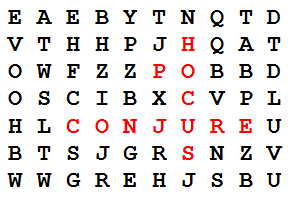
If π is expressed in base 26, then each of its digits can be associated with a letter of the alphabet (0=A, 1=B, … 25=Z). This produces an endless string of letters:
D.DRSQLOLYRTRODNLHNQTGKUDQGTUIRXNEQBCKBSZIVQQVGDMELM …
If the digits of π are truly random, then this string “emulates the mythical army of typing monkeys spewing out random letters,” writes Mike Keith. “Among other things, this implies that any text, no matter how long, should eventually appear in the base-26 digits of π.”
In examining the first million letters, Keith has found that the word CONJURE appears at position 246,556. If a carriage return is added after each 2,736 letters, then we have a two-dimensional field in which further words appear, in the style of a word search. Now HOCUS and POCUS appear, intersecting CONJURE (with POCUS in the shape of an L).
When each row is 14,061 digits long, then ALPHA, OMEGA, and GOD appear in a group near position 148,655. And when rows are 13,771 digits long, then DEMON and SATAN appear interlocked near position 255,717. Keith even found the makings of a charming haiku near position 554,766 when rows are 1,058 letters long:
Sun, elk in water;
Oho! For her I’ll try to
Be a hero yet.
More here. See also A Hidden Message and Equidistant Letter Sequences.
“Atmosphere Never Dark on a Windy Night”
Several years since, when travelling by night in the mail coach, in the depth of winter and during the absence of the moon, I was surprised to observe, that, though dense clouds covered every part of the horizon, and not a single star could be seen, yet the night was far from being dark, and large objects near the road were easily discerned. On expressing my surprise to the driver, he replied, ‘The wind is very high, and during a great many years that I have been upon the road, I never knew it to be dark on a windy night.’ The observation was at that time new to me; but subsequent experience has convinced me that it was true.
— B. Hampstead, in The Magazine of Natural History, May 1831
Anecdotally, I’ve noticed that this seems to be true — the darkest nights are calm, regardless of cloud cover. Why?
Two Gruesome Incidents
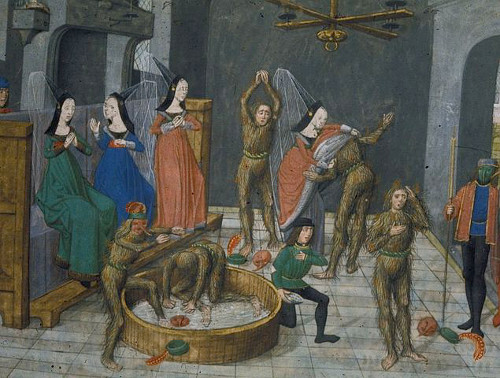
On Jan. 28, 1393, during a riotous wedding at the royal palace of Saint-Pol, Charles VI and five French nobles dressed up as wild men using linen costumes covered with pitch and hair and ranged among the guests, howling like wolves and daring them to guess their identities. One guest approached too closely with his torch and set them ablaze. The Duchess of Berry had the presence of mind to throw a cloak over the king, and one of the nobles managed to dive into a barrel of water. “The other four were burned alive their flaming genitals dropping to the floor, [the Monk of St. Denis] remarks with a sharp but on this occasion rather unsavoury eye for detail, releasing a stream of blood,” notes Jan R. Veenstra in Magic and Divination at the Courts of Burgundy and France. “Three of them, the count of Joigny, the bastard of Foix and Aymeri de Poitiers were deeply mourned; a fourth victim, Huguet de Guisay, was left wailing in agony for three days before he too expired, but he was not mourned, the Monk of St. Denis explains, since he was a vicious man and people were glad to see him perish.”
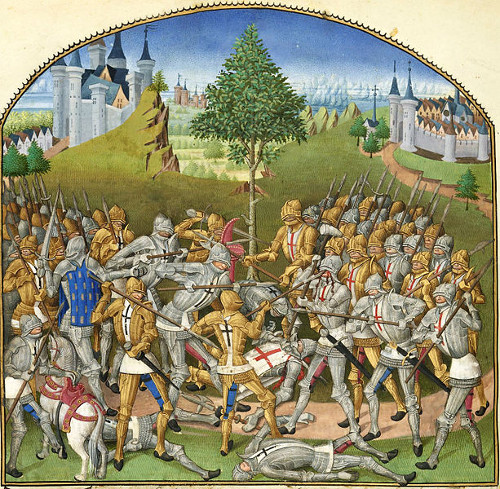
On March 26, 1351, during the Breton Civil War, the contending fortresses of Josselin and Ploërmel agreed to an organized contest: Each side would select a team of 30 knights who could fight with any weapons they chose, including swords, maces, and battleaxes. Referees would signal the start of the melee and manage truces for refreshments and medical care. The fight went on for hours. In the end, English commander Robert of Bamborough, of Ploërmel, and eight of his men were slain and the rest taken captive; the pro-French Breton team lost four (or perhaps six) knights; and both sides were badly wounded. The “combat of the thirty” made heroes of its victors and became a symbol of chivalry during the Hundred Years’ War; in 1373, Jean Froissart saw firsthand the honor accorded to a survivor who displayed his scars at a feast given by Charles V.
(Thanks, Davecat.)
“Extraordinary Wave in the Channel”
The Weymouth and Channel Islands Steam Packet Company’s mail steamer Aquila left Weymouth at midnight on Friday for Guernsey and Jersey. On her passage across Channel, the weather was calm and clear, and the sea was smooth. When about one hour out, 1 a.m., 31st March, 1883, the steamer was struck violently by mountainous seas, which sent her on her beam ends and swept her decks from stem to stern. The water immediately flooded the cabins and engine room, entering through the skylights, the thick glass of which was smashed. As the decks became clear of water, the bulwarks were found to be broken in several places, one of the paddle boxes was considerably damaged, the iron rail on the bridge was completely twisted, the pump was broken and rendered useless, the skylight of the ladies’ cabin was completely gone, and the saloon skylight was smashed to atoms. The cabins were baled out with buckets, while tarpaulins were placed over the skylights for protection. Five minutes after the waves had struck the steamer, the sea became perfectly calm. Several of the crew were knocked about, but no one was seriously injured.
— Symons’s Monthly Meteorological Magazine, April 1883
